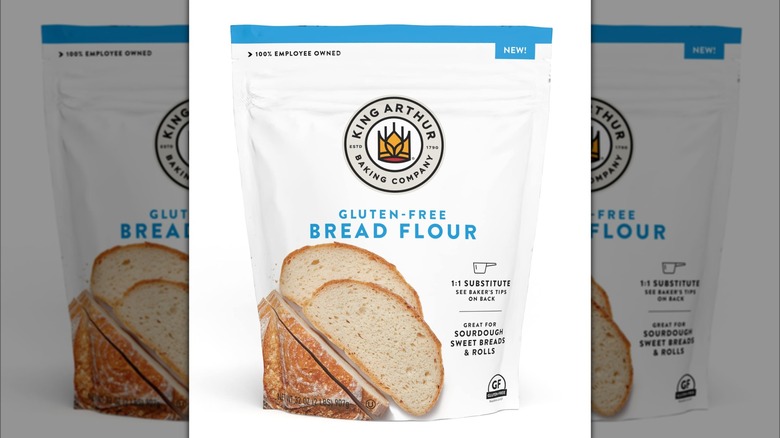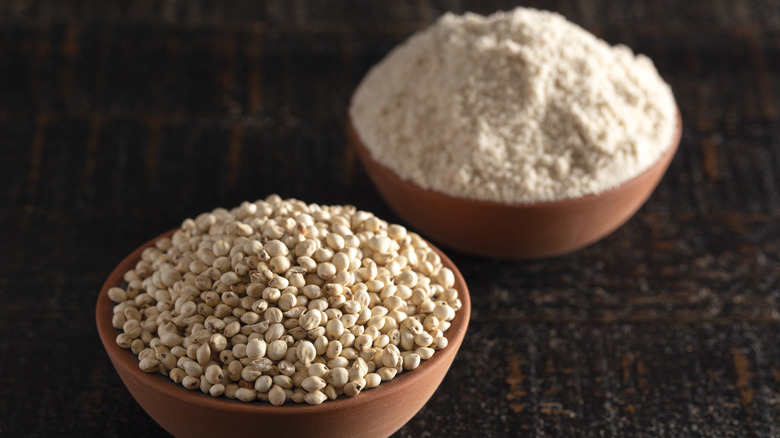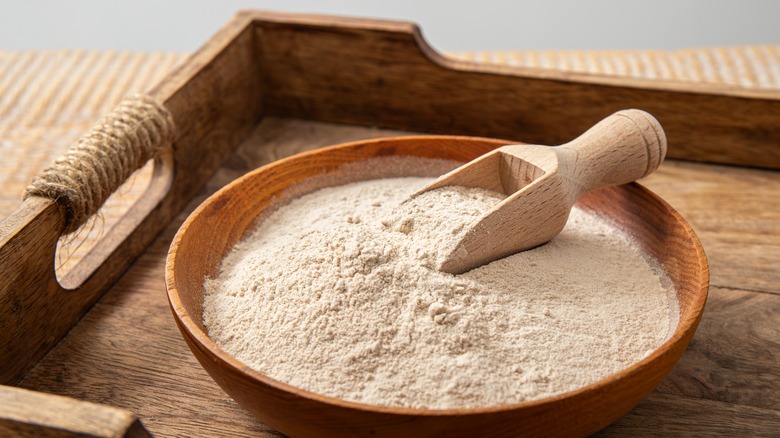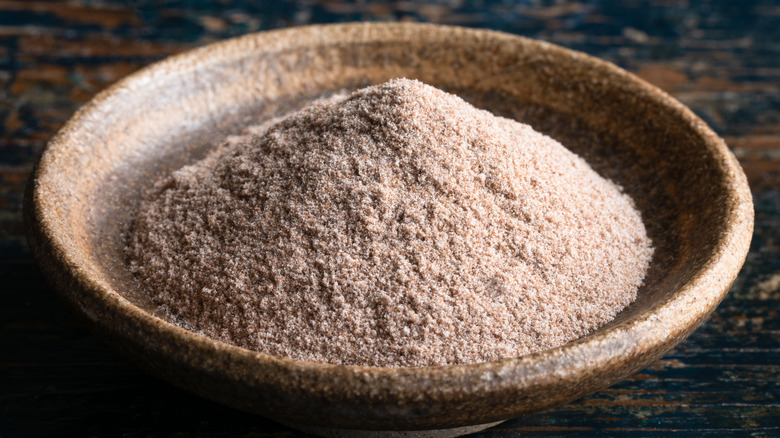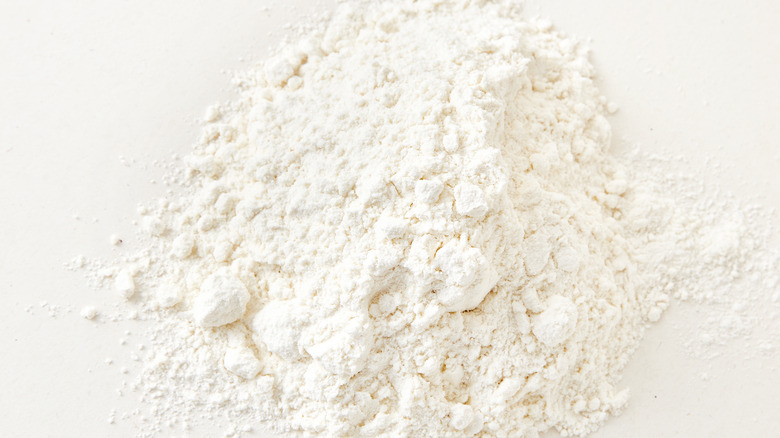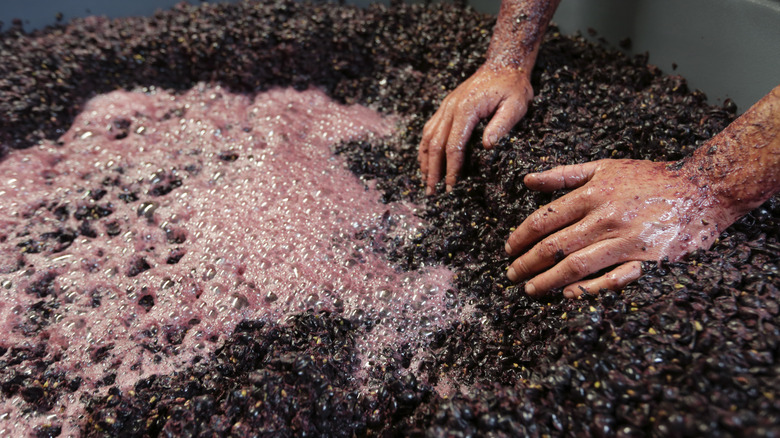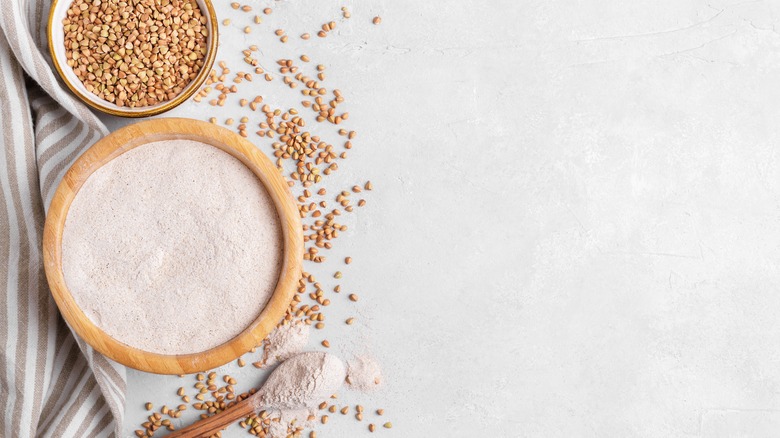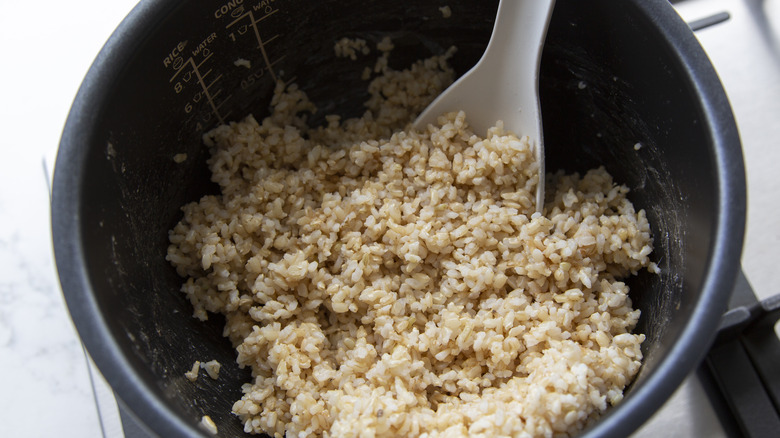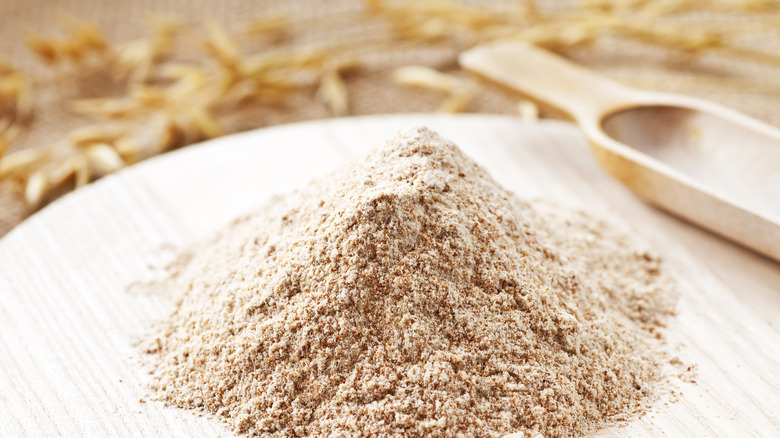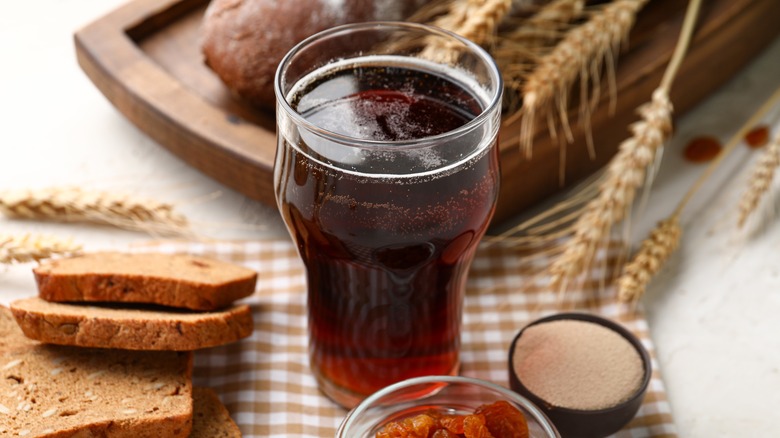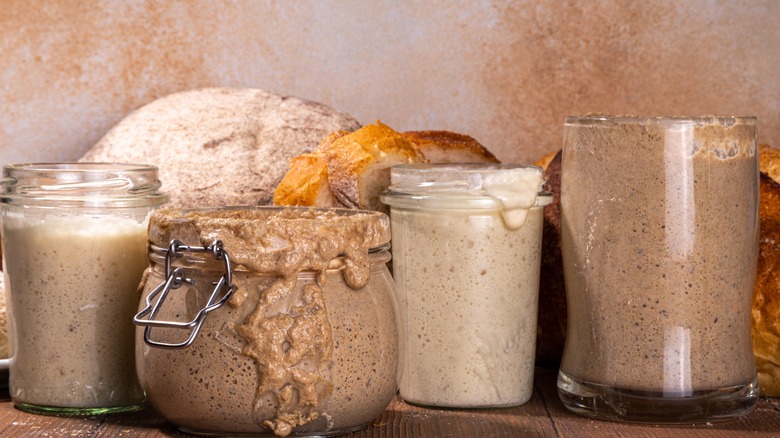Bread Experts Share 11 Tips For Making Gluten-Free Sourdough
We may receive a commission on purchases made from links.
Very few of the early COVID-19 pandemic-era trends remain. We doubt anyone is still hoarding toilet paper, and there hasn't been much news recently about people still eating horse dewormer as a way to stave off ailments. But one trend that really rose in popularity back in 2020, and has seemingly not ceased, is sourdough baking.
Sourdough refers to baked goods that are made with a sourdough starter. Essentially, it's a culture of wild yeasts and bacteria that ferment and grow on a mixture of flour and water. Caring for a sourdough starter requires daily feeding and removing the sourdough discards. But once you have a steady, well-sustained culture going, you can use it for seemingly everything. Stir it into chewy chocolate chip cookies or stick to classic bread recipes.
The lion's share of sourdough recipes focus on using wheat-based flours, like bread flour, whole wheat, or all-purpose flour. But, believe it or not, it is possible to cultivate a vibrant colony of wild microbiota on a gluten-free flour, too. That way, you can use this recipe for all of your gluten-free favorites, including breads, desserts, and more. We consulted with several baking professionals, including cookbook author Allyson Reedy, co-owner of Bread Bros Amy Jam, and chef Hervé Guillard — the director of education at the Institute of Culinary Education's (ICE) Los Angeles campus — about how to ensure success when making a gluten-free sourdough starter.
1. Start with a whole grain gluten-free flour
The easiest way to whip up a gluten-free sourdough starter is going to be to look for a wheat-analogous product. Some gluten-free flours tend to have more fiber or be a little bit more gritty than white flour, which can alter the texture of your sourdough and the microbes you're trying to attract. Plus, if you consider yourself to be a novice when it comes to gluten-free baking, you may want to use measure-for-measure gluten-free flour to make your sourdough.
Allyson Reedy recommends using a gluten-free flour blend to get your sourdough culture going. "You'll start by mixing a roughly 50/50 blend of the flour and water (use just a smidge more flour than water) in a Mason jar," she explains. "... It can take 10 to 14 days to get a gluten-free starter going, so don't give up! You'll know it's ready when it's doubled in size, has lots of big bubbles, and is nice and fluffy."
One of our favorite measure-for-measure flour blends to work with is from the King Arthur Baking Company. Not only does the brand make a standard gluten-free flour, but it also makes a gluten-free measure-for-measure bread flour. It contains starches and ingredients that will mimic the same elasticity and protein content as traditional wheat flour. "[Flour brands] usually have some basic recipes on their websites as well to get you started. They've done the research so you don't have to," Hervé Guillard explains.
2. Use sorghum flour for a soft bread with moderate sweetness
If you're not familiar with gluten-free baking, sorghum might not resonate with you. But folks who frequently whip up gluten-free muffins and treats may have come across it a time or two. It's a flour that's highly desirable for its smooth texture and balanced mouthfeel; you won't notice too much graininess or nutty flavor when you use it in your recipes.
Sorghum flour is one of Jam's favorites for making gluten-free sourdough with. "I swear by sorghum flour when I'm baking gluten-free products because it not only brings nutrition to the table, but it also adds a mild sweetness and makes the bread softer," she explains. Jam also shares that she uses tapioca and potato starch in tandem with the flour to prevent it from getting too dense.
Jam also underscores the importance of hydration when it comes to making a gluten-free sourdough. "When I work with sorghum flour, I make sure the dough is really moist, going for a water content of about 90-100%," she says. "This is important for building the right structure and keeping the bread just perfect." The hydration ratio refers to the amount of water that you should be using for every 100 grams of flour. So, for 100 grams of sorghum flour, you should be using about 90 to 100 grams of water. In comparison, traditional wheat sourdough caps the hydration anywhere between 65% and 90%.
3. Add psyllium husk to help your sourdough stretch
Mastering gluten-free baking often involves getting an entire arsenal of ingredients ready. While making a traditional sourdough really only requires two ingredients, water and wheat flour, your gluten-free sourdough will require you to play around more with starches and ingredients to give your dough its trademark elasticity. One of those, which Jam cooks with frequently, is psyllium husk.
"Psyllium husk powder is another must-have in our kitchen," Jam shares. "It's a fantastic binder for gluten-free baking and, unlike xanthan gum or guar gum, psyllium husk adds a similar elasticity and structure you'd find in gluten-containing doughs." This is because it produces a gelling effect when combined with other ingredients. In short, this property mimics the same strengthening effect as gluten and will ensure your dough gets the proper rise. Jam also shares an important tip with us about working with psyllium husk. "I always hydrate the psyllium husk in water before it goes into the dough," she explains. "This creates a gel that not only improves the dough's texture, but also makes it a lot easier to handle."
The hydration process can take anywhere from 15 minutes to up to 45, so you'll want to be mindful of this when preparing your dough. Or, you can just opt for using a pre-soaked psyllium gel instead and skip the rehydrating step.
4. Scoop in teff flour for a nutty flavor
Another seed that should be on your gluten-free radar, especially if you're making sourdough bread, is teff. "It adds a unique earthy, nutty flavor that really improves the tanginess of the sourdough," Jam explains. As a general rule of thumb, when substituting white and teff flour, you'll want to stick to a 1-to-1 ratio. The texture of this powder, though, lends itself better to gluten-free batters that don't require the same structure as bread. So, while you can use it as a 1-to-1 replacement for white flour in muffins, you will want to add in some supplementary flours for your bready applications, like buckwheat or a measure-for-measure gluten-free flour.
In terms of sourdough specifically, it's important to note how the teff's texture could alter your finished starter. "Teff can weigh your dough down, so I balance it with lighter flours like white rice flour and allow the dough to ferment a bit longer," Jam explains. "This extra step does wonders for flavor and texture, which makes your gluten-free sourdough come much closer to traditional varieties."
5. Use glutinous rice flour to give your dough some stretchiness
If you don't do a lot of Asian-inspired baking, you may not have ever come across glutinous rice flour. But, if you've ever sampled those delicious frozen ice cream mochi or eaten Thai mango sticky rice, you'll likely know glutinous rice flour better than you'd think. Despite what its name might suggest, glutinous rice flour contains no traces of gluten, which makes it an excellent addition to gluten-free baking.
In particular, Nathan Myhrvold, founder of Modernist Cuisine and the co-author of "Modernist Bread," adds this rice flour to his sourdough recipe. He told Tasting Table in an interview that he substitutes bread flour in his sourdough with a medley of gluten-free flours, including glutinous rice flour. "Of these ingredients, the glutinous rice flour played a major role in our baking success: When hydrated in doughs and then baked, it retains a particular chewiness reminiscent of gluten," he says.
It's important to note that you can't just load up your sourdough willy-nilly with this flour, as it tends to be quite sweet. Myhrvold adds white and brown rice flour with the glutinous rice flour, along with starches like tapioca and cornstarch. He also swears by some xanthan gum, a common gluten-free baking ingredient. "It absorbs water and makes the mixture more viscous, helping evenly disperse and suspend the starch particles in the crumb and partially substituting for the structure that gluten would normally provide," he explains.
6. Use a fruity ferment to kickstart your sourdough starter
Wait, what is fruit doing in a sourdough recipe? Although it may seem a bit unconventional, you can actually use fruit to kickstart the fermentation in your starter, per Hervé Guillard. He notes that you'll have to dedicate about a week of your time to getting your fruity ferment ready before you can mix it with your gluten-free flour.
Guillard recommends using a ½ pound of organic, skin-on fruit (he prefers dates and fresh peaches) for every 2 cups of filtered water. After the fruit has fermented in the water for a week, he explains how it should be smashed or blended together, then strained to remove the large chunks of fruit. Once you have your fruity ferment, you can mix in your ½ pound of gluten-free flour and get right to work; there's no need to wait the extra time that you would need to wait for a sourdough culture to properly ferment before you bake with it. If you wonder when the right time is to use your ferment, you can always purchase pH test kits. Once it reads a 4, you should be good to go.
There are some fruits that won't work for this technique, including mango, pineapple, kiwi, and papaya. These fruits contain a special enzyme, actinidain, that inhibits protein from correctly developing, which can create issues with the texture and rise of your sourdough.
7. Try buckwheat flour in your gluten-free sourdough
Buckwheat flour is a commonly used ingredient in the gluten-free kitchen. Whole buckwheat has a profoundly earthy flavor that will really elevate your sourdough in the same way that adding teff to it would. Like teff, buckwheat can be quite heavy, so you'll want to use it in tandem with other lighter gluten-free flours, like brown or white rice flour.
You can make your own starter out of buckwheat flour, but be forewarned: The process takes much more time than other gluten-free flours. You won't notice much activity (in the form of bubbles) for the first 10 to 14 days. You may also notice an outcropping of pink liquid in the top of the starter; this may be because of the anthocyanin compounds in the buckwheat. So, you'll have to have a grasp of what to look for before you just assume your starter has gone bad and needs to be thrown out.
The most important thing to know about adding buckwheat to your sourdough is that the finished bread (or whatever baked good you use it for) will be dark in color, so it can shift the entire balance of your bread to something that's more gray and almost tonal in color. It may not look super appetizing, but the nuttiness of the buckwheat flour will make it taste quite delectable.
8. Brown rice flour is a plausible alternative for gluten-based flour
One of the most common types of flour used for gluten-free baking is rice flour. There are two predominant types of flour within this category: white and brown. The white flour is more analogous in flavor to plain white wheat flour, while the brown rice tends to have a nuttier and more complex flavor. Regardless of which type you select, it's important to note that the flour tends to be sticky and not behave like wheat-based flour. So, a large portion of the recipes that use rice flour-based starters will also cut in some gluten-free flour blend later on to help make it a bit lighter and ensure that it behaves. When Hervé Guillard makes his brown rice starter, he uses a mixture of rice flour, sweet potato flour, and plantain flour, along with a bit of xanthan gum.
Like a traditional wheat sourdough, you can start the recipe by mixing equal parts brown rice flour and water, then adding a 50/50 ratio of gluten-free flour and rice flour around week three. This medley will give you the body and texture you're looking for, along with a subtle malty flavor.
9. Swap millet flour into your gluten-free sourdough
Millet flour is another gluten-free flour that you should have on your radar, especially if you're craving something nutty and flavorful. You'll need to look for pearl millet in the store — not pearled millet. The latter still contains its hull, and removing it is just one more step in the sourdough process that you'll want to avoid if you can.
As with other types of flour, like buckwheat and teff, you'll want to avoid making a sourdough that's 100% millet. The grain can be sweet and delectable, but it is quite heavy, and needs to be cut with a lighter flour, like brown rice flour, to ensure the proper rise. You'll also want to make sure your millet seeds are finely ground before you mix them into your starter; otherwise, you won't get the proper consistency. The benefit of using millet flour over buckwheat flour is that it tends to have more activity earlier on; you should start noticing activity within about three days rather than having to wait several weeks. Once your sourdough is bubbling and active, it's time to get the rest of your ingredients and get crackin'.
10. Skip the beer
You shouldn't just be mindful of the gluten in the base of your recipe; you'll also have to consider the gluten content of other ingredients you're baking with. For example, some folks will add beer to their sourdough to imbue it with those perfectly malty, toasty notes and also to promote a browner hue. The beer will also accelerate the yeast activity, since it contains digestible sugars, which can decrease your proofing time significantly.
But not all beers are gluten-free. If you can find a gluten-free beer, like one made from certain types of barley, then by all means throw it into your bread recipe. But otherwise, you may be relegated to reading and scrutinizing labels to ensure that your bread is safe for folks who have celiac or who are gluten-intolerant. The same goes for other ingredients that you add to your sourdough — at any point in making it. Depending on who will be eating the bread, you may need to check the labels to ensure that everything is certified gluten-free before you turn on your oven and get baking.
11. Tips for making gluten-free sourdough
Gluten-free sourdough behaves differently than a wheat-based one and also has differing strength and textural properties — all of which are important to understand before you pull out your ingredients and start cooking. According to Hervé Guillard, "Because gluten-free bread lacks the extensibility of the gluten matrix, it is less forgiving. So, make sure that you feed your starter two days in a row prior to making bread. It should be very bubbly and active to ensure a nice rise." In other words, this is not the time to let your sourdough get super sour in the fridge by not feeding it; you need that activity to get the proper rise. He also shares that because gluten-free bread doesn't have the same structure as wheat, you won't need to knead it as much to shape your loaf.
Guillard also recommends performing an overnight fermentation to max out the flavor in the dough. "Leave the dough covered and undisturbed overnight for a delicious morning bake," he instructs. While this may require that you plan ahead, the flavorful loaf (or sourdough-infused bake) that you get will be well-worth it.
Furthermore, Guillard shares that you should select a baking pan that will help your sourdough rise to its fullest potential. For a classic sandwich bread, he recommends using a tall loaf pan to encourage the bread's rise. Though, for a crusty loaf, he suggests using a Dutch oven, which will trap the steam in and form the perfect crust.

